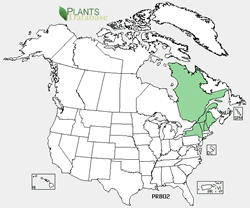Plant of the Week
 Prenanthes boottii range map. USDA PLANTS Database.
Prenanthes boottii range map. USDA PLANTS Database.
 Alpine rattlesnake root. Photo by Christopher Mattrick.
Alpine rattlesnake root. Photo by Christopher Mattrick.
Alpine Rattlesnake Root (Prenanthes boottii, Synonym: Known as Nabalus boottii D.C.)
By Chris Mattrick, White Mountain National Forest Botanist
Alpine or Boott’s rattlesnake root (Prenanthes boottii, Synonym: Nabalus boottii) is named for John Wright Boott. J. Wright Boott was a successful merchant and member of a prominent Boston area family in the mid 19th century. He was an early member of the Boston Natural History Society and the Massachusetts Horticultural Society both institutions remain active today (the former now named the Boston Museum of Science). Boott was introduced to botanical exploration by his brother Francis Boott, who along with William Peck (Geum peckii), Jacob Biegelow (Carex bigloweii) and Edward Tuckerman (Carex tuckermanii) was one of the early botanical explorers of Mount Washington in NH. Francis Boott passed along his love of botany and exploration to his younger brothers and in 1816 traveled with his brother Wright to the alpine regions of the Presidential Range in New Hampshire’s White Mountains. Francis moved to England in 1820, although he maintained a lifelong correspondence with Asa Gray the pre-eminent American botanist of that time. J. Wright Boott continued to visit the White Mountains on botanical and ornithological forays and in 1829 discovered a small previously unknown species of Prenanthes. Asa Gray who first described the species named it Prenanthes boottii in recognition of its discoverer J. Wright Boott (and perhaps for his friend and colleague Francis Boott) A globally rare species, this small member of the Nabalus genus is found only in the alpine areas of northern New England and the Adirondacks of New York and no where else in the world. The harsh environment of the alpine zone requires special adaptations for survival. The low growth habit of this species, only reaching 3 to twelve inches in height, is one of these adaptations. Another is the large and showy nature of the flowers to attract pollinators. The flowers of the alpine rattlesnake root are the largest of the three Nabalus species occurring in the alpine zone. Ten to eighteen white flowers are gathered in each flowering head that bloom from July through September. This species also seems highly tolerant of periodic disturbance often colonizing the margins of trails and other areas impacted by natural or human influenced disturbance events.



